Whenever a designer is not even set to design the product but just thinks of designing it or even enhancing the already existing one. The thought of conducting a UX survey invariably takes center stage. Whether you’re a designer or someone related to the field in any way UX surveys might be within your way. But what exactly is a UX survey?
Continue reading the blog and all your queries about UX surveys will find their answers, from what is it? Why are they conducted? Different types of UX surveys? where to start the survey? To What tools do you need? And most importantly, what questions the questionnaire should include? Furthermore, I have concluded the blog by providing you with tips and tactics essential for conducting a successful UX survey.
However, before getting started with the actual process of UX surveys. You must understand what it is, and how it is different from marketing surveys. UX surveys are often confused with marketing surveys and are even used interchangeably. However, there’s a huge difference that sets them apart from one another.
What Are Surveys for UX Research?

UX survey is one of the most prevalent UX research methods. It is used for collecting both qualitative and quantitative insights from your users. It brings into light their interactions and experience with your website or any digital product.
It helps you understand customer behavior better and how they perceive and engage with your product. This information can be instrumental in determining what aspects of your product are effective and what should be improved. Hence allowing you to enhance the overall user experience (UX) for your product.
Wondering why we need UX surveys? It’s crucial to recognize that user experience can impact individuals in several ways. It also influences consumer decisions. According to a survey, a staggering 82% of consumers state that they are more likely to recommend a company to others only because of subpar user experiences.
Difference Between Marketing and UX Surveys
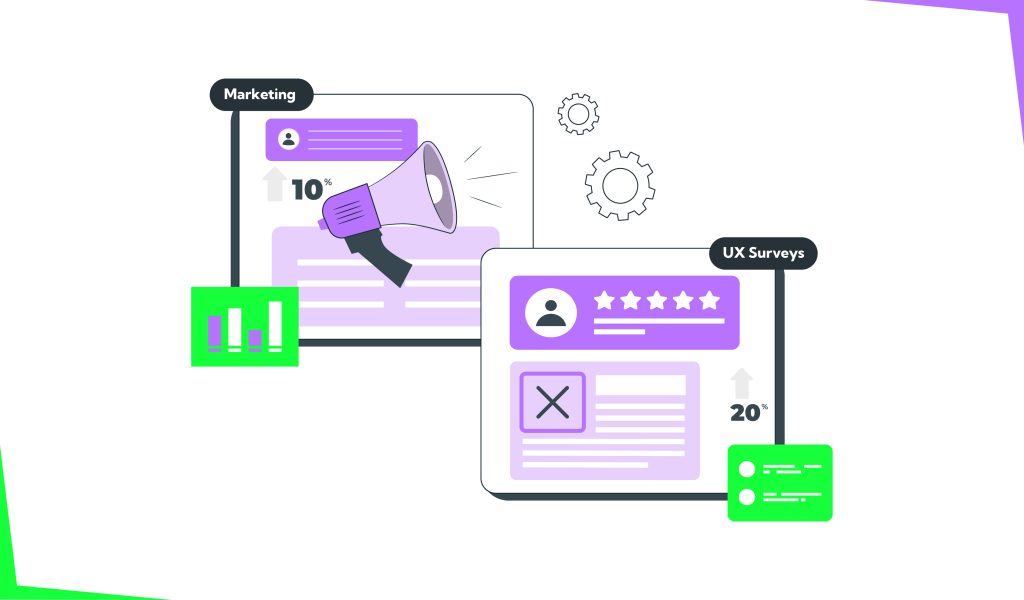
| Marketing Surveys | UX Surveys |
|---|---|
| Marketing survey serves as a tool for collecting market-related information. Like demographics, product demand, and optimal audience outreach strategies. | UX survey is centered on the user’s interaction with a product and scrutinizes usage patterns. |
| It identifies potential consumers. | It uncovers challenges faced during the product’s utilization. |
| It revolves around strategies for selling a product effectively. | It is focused on the customer-product interaction. |
When Should You Conduct UX Surveys?
Conducting UX surveys or gathering customer feedback isn’t a one-time thing. It’s an ongoing process that requires continuous attention and action. Though UX surveys can be conducted at any stage to improve your product significantly. The best time to conduct in-depth user research would be before designing the UX and UI. That is at the ideation or prototyping stage.
UX surveys should be conducted at multiple touchpoints throughout the prototyping stage. This approach will help you determine what’s preventing your user from progressing through each stage. Hence you can easily eliminate those factors and enhance the overall user experience.
UX survey can be more cost-effective and time-saving if performed during the ideation stage. Rather than making adjustments after the product has been launched. For instance, a study states that designers spend half their time fixing issues that could have been preemptively addressed through proper UX research and at 100 times less expense.
To implement effective UX surveys. You must have a clear picture of the different types of survey methods used in UX research. Before you actually delve into the design and implementation phases.
Different Survey Approaches in UX Research
There are several types of UX surveys for you to choose from, each serving specific purposes in the design and improvement process.
Some of the types of UX surveys include:
Usability Surveys:
The ease of use and efficiency of a product can be evaluated using these surveys. The questions generally revolve around navigation, task completion, and overall user satisfaction. It can be conducted during and after the designing phase to identify areas of improvement.
Satisfaction Surveys:
If you wish to measure whether the users are content with your product or service, these surveys could be the best. The commonly used metric here is the Net Promoter Score (NPS), which gauges how likely the users are to recommend the product to others. These surveys take the help of open-ended questions to allow users to express their sentiments in detail.
Task Success Surveys:
It gauges how well users can accomplish specific tasks within a product. These surveys identify obstacles or pain points in the user journey. Hence can provide a roadmap to the designers for the refining of user interface and enhance task efficiency.
Perception Surveys:
Understanding how users feel about your product, and what are their opinions and perceptions is vital. The questions on brand perception, trust, and emotional engagement help understand the emotional aspect of the user experience.
Accessibility Surveys:
The questions of this survey explore the usability of assistive technologies, the clarity of content, and the overall accessibility of the interface. Hence assesses how well a product accommodates users with disabilities.
Exit Surveys:
These surveys can help you keep the users intact and enhance user satisfaction. Helping you understand the reasons for leaving when users are about to leave a website or application. This type of survey can reveal issues leading to user abandonment and inform strategies for retention.
Onboarding Surveys:
Onboarding surveys help understand the user’s experience. Especially during their initial interactions with a product. It covers questions on the clarity of onboarding instructions, the ease of setup, and users’ comfort levels with the product features.
You can choose the perfect type of survey depending on your goals and the questions you aim to get answers for.
As a very popular saying goes “Every dollar invested in UX brings around a hundred dollars in return”. It underscores how impactful User Experience (UX) is on the overall success and profitability of a product or service. So let’s understand the pros along with the cons that it brings to the plate.
Pros and Cons of UX Surveys
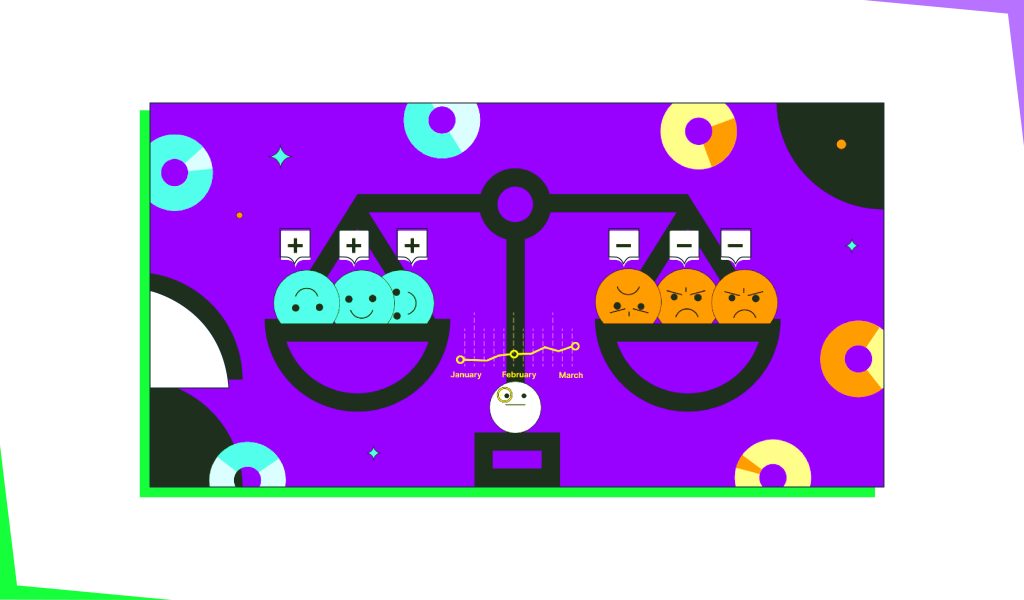
You can never deny the fact that UX surveys are the best method for data collection. Along with these, surveys if performed in the right manner can also get you several other benefits. However, also comes up with several demerits.
| Pros | Cons |
|---|---|
| Surveys help you gather quantitative data and insights about your products. | Irrelevant or poorly framed survey questions get you inaccurate results. |
| It backs up your design strategies with data, providing confidence to stakeholders and decision-makers. | Surveys may not directly reveal actual behavioral patterns; requiring additional data analysis. |
| A cost-effective method to collect feedback from a large user base. | The survey process can be time-consuming, taking weeks to complete and analyze. |
| Ideal for collecting feedback regarding a new or beta product or service. | Not suitable for gathering qualitative data on customer needs or usability problems. |
| Structured surveys maintain objectivity in data collection, reducing bias and ensuring standardized user feedback. | Surveys don’t provide in-depth insights related to user experience. |
| It helps you identify early adopters of your product based on how the users responded. | Users may find it challenging to accurately articulate their experiences. Hence resulting in responses that lack context. |
| Your design team can now make easy and data-driven decisions. | Survey responses may be influenced by the way questions are framed, introducing bias in responses. |
Steps to Conduct Effective UX Surveys?
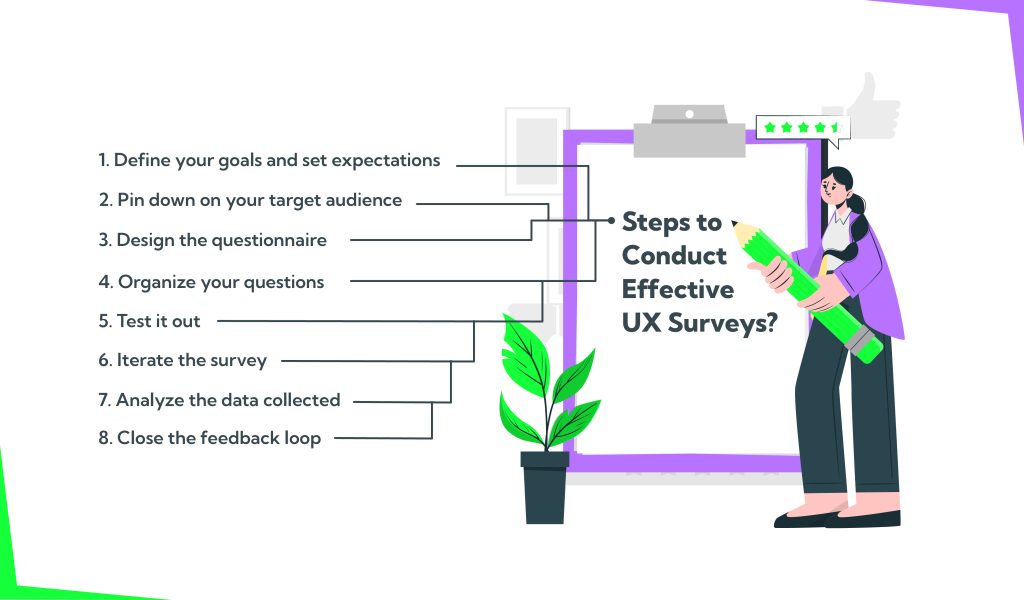
Now that you have a clear understanding of UX surveys, their types, and their significance. Let’s explore the systematic approach to building a compelling UX survey that aligns with your objectives.
Define your goals and set expectations:
Before sending out a UX survey, the first thing to do is outline what outcome you want from the survey.
What aspects of your product or design do you want to improve? How do you want to understand the users? Within this step itself, you should determine how much data and how many respondents you will need to accomplish your result.
Pin down on your target audience:
The next step would be to identify the target audience. Since it’s impossible to get relevant feedback from your audience without asking the right questions to the right users.
This step ensures that questionnaires are sent to the right users. Ultimately avoiding unnecessary inconvenience. An easy method of doing this is to merely segment the users into demographics, locations, etc., based on the objective of your survey.
For example, if you wish to analyse the performance of a specific feature. It would be always best to take opinions from users who have used it more than once.
Design the questionnaire:
Once you have your goals defined, the next step is to convert your core objectives into UX survey questions, so that you can get the appropriate data. The survey questions must be simple, straightforward, and relevant. Ill-constructed questionnaire accounts for 75% of online survey failures.
This is also the stage where you decide on the survey format to best meet your needs and match the visual essence of your survey.
Whether your survey questionnaire must comprise multiple-choice questions or open-ended ones?
Whether it will use icons or numbers to gather quantitative data?
Additionally, you can also decide on the strategic use of colors, fonts, and icons. To harmonize the survey design with your company’s branding.
Organize your questions:
Your questions must be organized logically to create a seamless flow. It helps avoid abrupt transitions that might confuse respondents.
Test it out:
Once the survey is created, it would be best if you test it with pilot users. To check if it could be easily understood and whether there are any flaws.
Iterate the survey:
If the pilot users have any difficulties with answering the questions. You must address it by iterating the questionnaire and the overall survey accordingly.
Analyze the data collected:
Once sufficient data is collected, you must analyze it to reach the objective. Analysis tends to be the most crucial part of this process. Since it involves transforming data into actionable insights that facilitate product improvement.
Close the feedback loop:
Conclude the process by acknowledging your customers’ responses. It can be done by communicating your commitment to improving the product and their overall experience with your brand.
How to Bulletproof Your Surveys to Ensure You Get Quality Data?

By now, it’s evident that nothing can beat the useful, actionable user insights of UX surveys to understand how users really feel about their interactions and experiences with your product. Hence the best way for you to address specific pain points and prioritize product changes can be provided.
Here are essential steps to follow before you launch your survey to bulletproof it:
1. Avoid Bias: Before you launch your survey, check that the questions are not biased. Furthermore, the questionnaire shouldn’t contain leading questions. That steers respondents toward a particular answer. Neutrality in your wording will ensure that participants feel more comfortable. Hence can provide honest and unbiased responses.
2. Ask the right questions: UX surveys must be able to obtain appropriate data and user insight. This can be done by asking questions directly related to the problem you wish to solve. If you are unsure about the actual problem. The questions must be such that help you identify pain points. Hence you can end up understanding the problem being faced. It would be helpful if you start by asking a few closed-ended questions to get quantitative data or to segment by user cohorts. Then follow up with open-ended questions that help you understand the subject on a deeper level.
3. The questionnaire must be short and to the point: Keep the questionnaire as relevant, quick, and easy to complete as possible. Since it takes less effort for respondents to answer short and simple questions. Hence they are more likely to complete the questionnaire.
4. Sample continuously and share your findings: Your team is never really finished building and improving your product. So you should never stop asking for feedback. However, keep in mind that survey results can be impacted by external factors. Which are a disproportionate number of new or inexperienced users or failure to distribute representative cohorts to both versions of an A/B test. By sampling over a long period, you can reduce the risk of your UX survey being skewed by unique events.
5. Ensure survey cool-off periods: On-site surveys can distract users from their usual experience with your website or product. Additionally, multiple invitations to external surveys can become irritating. Plan cool-off periods between surveys to avoid interfering with the user experience and repeatedly re-surveying individual users.
6. Show surveys to relevant users: It’s vital to trigger surveys for relevant users only. You should aim to trigger surveys based on customer engagement and where they are in their journey.
7. Don’t force surveys on customers: Some users may not be in the mood to complete the survey few a times. Hence may not provide you with appropriate data. Don’t cause friction by forcing them to fill out the form to continue using the product. Allow them to skip the survey, or even better, offer an always-on feedback widget so they can share their ideas whenever they feel like it.
Best Tools for Conducting UX Surveys

By now you would be willing to conduct UX surveys right? As it helps you understand the users and also improves the interaction between users and a product or service. But are you wondering which tools to use? There are a wide range of tools available for conducting UX surveys. Each offers unique features and advantages.
Here are some of the best tools for conducting UX surveys:
1. SurveyMonkey: It is a versatile survey platform that allows you to create and distribute surveys easily. It provides a variety of question types, customizable templates, and robust analytics. It is also user-friendly and best for users both at beginners and advanced levels.
2. Typeform: It is known for its visually appealing and interactive surveys. It uses a conversational format, engaging users with one question at a time. This tool is suitable for creating engaging and mobile-friendly surveys, making it a good choice for UX research.
3. Google Forms: Google Forms is a free and straightforward tool for creating surveys. It seamlessly integrates with other Google Workspace tools, making collaboration and data analysis easy. It is also suitable for quick surveys and is especially convenient for teams already using Google’s suite of products.
4. Hotjar: Hotjar offers a suite of tools for UX research, including heatmaps, session recordings, and surveys. The survey tool enables you to gather feedback directly from users while they interact with your website. It is valuable for combining quantitative and qualitative data.
5. UserZoom: UserZoom is a comprehensive UX research platform. It includes survey capabilities along with remote usability testing and analytics. It is particularly useful for large-scale, longitudinal studies. It provides insights related to the complete user journey.
Some Other UX Research Methods to Be Used Along With UX Surveys?
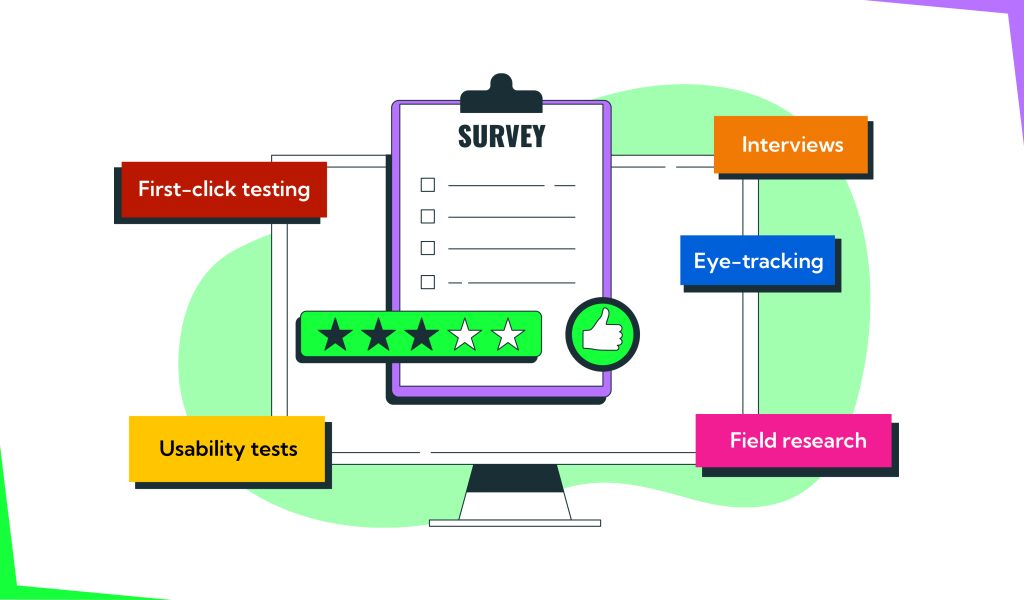
While UX surveys offer valuable insights, relying solely on them may not yield the desired outcomes or ensure the success of your product. The results from a survey alone might leave you uncertain about specific changes needed, how to implement them, or the exact pain points users encounter. Consequently, it is crucial to complement UX survey findings with additional research methods.
There are several other research methods, but the selection depends on your needs and the answers you are seeking. Other research methods that can be used include:
- First-click testing: A research method that can help you find out where and how quickly a visitor clicks on a website or application.
- Interviews: To get detailed information on user needs and experiences.
- Usability tests: It is highly impactful to understand what problems consumers face while using your product. Usability tests if done on only a very small group of five members can help eliminate 85% of UX-related issues.
- Field research: Gather information on user behavior and responses while they interact.
- Eye-tracking: If your budget allows, eye-tracking can reveal valuable information. Related to users’ initial focal points, where their attention lingers, and overall user experience. This method is particularly insightful for both marketing and UX research.
It’s essential to note that conducting UX research in-house without expertise may result in weak insights. Therefore, opting for the services of a UI/UX design agency for an end-to-end project can be more beneficial in ensuring comprehensive and effective UX research.
Conclusion
UX surveys are indispensable in shaping the optimal product and service for your business. It also enhances the user experience and satisfaction with your product. In contemporary design projects, UX research has become a very important part of any design project. UI/UX design companies prioritize it to avoid problems after finishing the project.
At Yellow Slice, we consistently prioritize UX research, placing it at the forefront of our approach. Get in touch with the Yellow Slice team of UX experts to design products that offer users an exceptional experience.
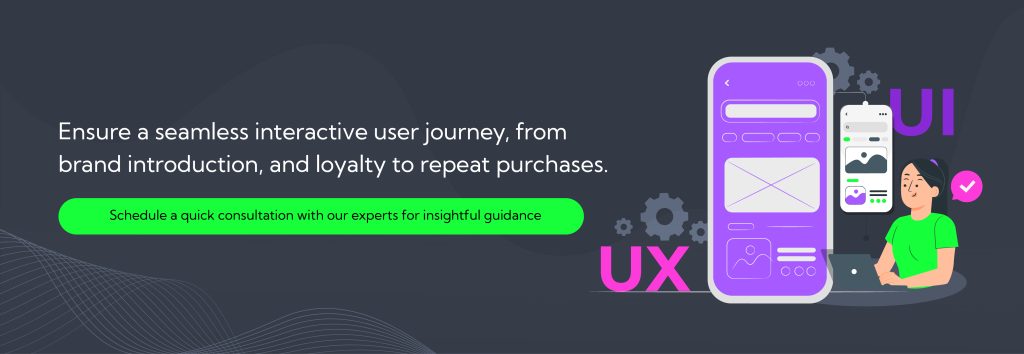
FAQs on UX Surveys
Whether a UX Survey is Qualitative or Quantitative?
A UX survey can be both qualitative and quantitative, depending on the research goals. It often combines aspects of both to provide a comprehensive understanding.
How Many Participants Do We Consider in a UX Survey?
The number of participants in a UX survey varies. However, the sample size must be such that allows for meaningful insights. It generally ranges from 20 to 200 participants.
How Do You Analyze UX Survey Data?
UX survey data can be analyzed using statistical tools for quantitative data. You can use thematic analysis for qualitative data. The process involves identifying patterns, trends, and actionable insights.
What Are the 3 Main Types of Questions?
The three main types of questions are open-ended questions, closed-ended questions, and scale-based questions (e.g., Likert scales)
What Are the Different Types of Questionnaires Used in UX Surveys?
The different types of questionnaires used in UX surveys include the SUS (System Usability Scale), SEQ (Single Ease Question), and NPS (Net Promoter Score) questionnaire.




